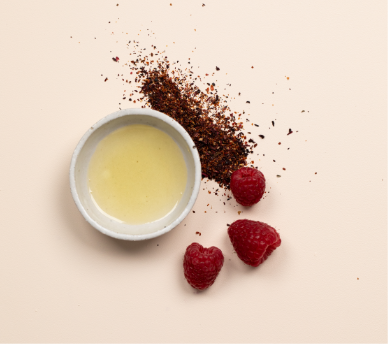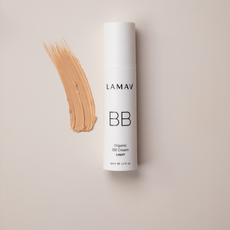What Are Comedogenic Ingredients and How Do They Affect Your Skin?
Comedogenic ingredients are substances commonly found in skincare and cosmetic products that have a tendency to clog pores. When applied to the skin, these ingredients can trap oil, dirt, and dead skin cells, creating the perfect environment for breakouts. This buildup leads to the formation of blackheads, whiteheads, and persistent acne. Some of the most common acne causing ingredients include lanolin, coconut oil, and certain types of silicones all of which are known to be highly comedogenic. Even if a product claims to be "non-comedogenic," it may still contain trace amounts of pore-clogging agents. That’s why it’s important to read labels carefully and research unfamiliar ingredients. Understanding which comedogenic ingredients to avoid is essential for maintaining clear, healthy skin especially if you're prone to acne.
The LAMAV Range is non-comedogenic, toxin-free and certified organic, suitable for all skin types.
1. Acetylated Lanolin
Lanolin is a natural ingredient produced by sheep's skin to keep their wool soft, just like we produce sebum to keep our skin soft. Lanolin is used in cosmetics and skin care products to provide softness and moisturization, but unfortunately, it's highly comedogenic! It might also be referred to as acetylated lanolin alcohol, ethoxylated lanolin, PEG 16 lanolin, or the less common name of solulan 16. Look for natural face moisturisers that nurture your skin!
2. Algae Extract
Algae extract for skin is often marketed for its hydrating and anti-aging properties, but it can be problematic for acne-prone individuals. Algae extract is comedogenic because it penetrates deep into the pores and accelerates the formation of micro-comedones. Additionally, algae are high in iodides, which can irritate the skin, triggering inflammation and leading to pustules. Despite its benefits, this ingredient is best avoided if you're dealing with breakouts. Found in some concealers and skincare products, algae extract is rated a 5 on the comedogenic scale—making it one of the more potent acne causing ingredients.
3. Benzaldehyde
This is an added fragrance used in cosmetics and skin-care products to give the product a nice scent. This, however, is one scent we can do without as it's rated at about 3.5 on the comedogenic scale and clogs and irritates the skin the way all artificial fragrances tend to do. Enjoy fresh-smelling scents with natural fruit extracts like the Sweet Orange Balancing Cleanser from LAMAV.
4. D & C Red
This will be seen as ‘D & C Red’ on the label, followed by a number. D & C # 19 has been banned. However, the following can still be found on the market. D & C Red # 3, D & C Red # 21, D & C Red # 30, D & C Red # 36, D & C Red # 40, D & C Red #27. Numbers 27 and 40 are rated high on the scale, whereas the others are rated as medium on the scale. These are added to give color to cosmetics, usually blush, and might just be the cause of those pimples on your cheeks and acne in general, as they are highly comedogenic. Look for our Anti-Ageing Mineral Makeup range that doesn't contain D&C Red.
5. Isopropyl Palmitate
Isopropyl palmitate is comedogenic and is commonly used in tinted moisturizers, foundations, and other creamy formulations. This fatty acid is rated a 4 on the comedogenic scale and is known to clog pores, especially on acne-prone skin. Even if a product is labeled ‘non-comedogenic,’ the presence of isopropyl palmitate should raise a red flag. It’s a classic example of how comedogenic ingredients can sneak into products that are marketed as safe for sensitive or breakout-prone skin.
6. Lauroyl Lysine
Lauroyl lysine is a silky-feeling ingredient commonly used in loose powders and finishing products. However, its benefits come at a cost. Lauroyl lysine comedogenic effects are a real concern—it forms a breathable barrier that actually traps debris and oil underneath the skin. The lauroyl lysine comedogenic rating is considered high, meaning it has a strong tendency to clog pores and trigger breakouts.
This is especially problematic in powders and foundations, as they cover your entire face and stay on for long hours. If you have sensitive or acne-prone skin, avoiding ingredients with a high comedogenic rating like this one is crucial.
For a safer alternative, choose LAMAV Mattifying Powder, which features non-comedogenic, nourishing ingredients like Vitamin C and Rosehip Oil. It delivers anti-aging benefits while helping to protect your skin without contributing to acne.
7. Lauric Acid
Lauric acid comedogenic properties make it one of the most pore-clogging fatty acids used in skincare. It carries a comedogenic rating of 4, which is relatively high. That means there's a strong chance it will block pores, especially on acne-prone skin. Despite this, lauric acid is still used in many popular cosmetic products for its antimicrobial qualities.
Unfortunately, those same properties don't outweigh the risk for breakouts. Even if your skin isn’t typically reactive, prolonged use of lauric acid could lead to unwanted pimples or skin texture issues.
8. Stearic Acid
Stearic acid is another common fatty acid in skincare, often used in moisturizers and foundations to create a creamy texture. While its stearic acid comedogenic potential is generally lower than lauric acid, it’s still something to watch for if you're prone to acne. The stearic acid comedogenic rating usually falls around 2, which is considered moderately low—but that doesn’t mean it's risk-free.
People with sensitive or congested skin may still experience blocked pores and flare-ups when using products that contain this ingredient. It’s often found in high-end formulations, but price doesn’t always equal skin safety.
That’s why our Anti-Ageing Mineral Foundation SPF15 is a better option. It’s made from 100% pure minerals, offers broad-spectrum SPF15 protection, and is free from pore-clogging agents—making it ideal for clearer, healthier skin.
9. Wheat Germ Oil
Wheat germ may be a nutrient-rich superfood when added to your diet, but wheat germ oil on your face is a different story. This oil has a comedogenic rating of 5, making it the most pore-clogging oil on this list. The wheat germ oil comedogenic rating places it at the top of the scale, meaning it’s very likely to clog pores and trigger breakouts, especially for those with oily or acne-prone skin.
Despite its antioxidant properties, this ingredient is best avoided in facial products if your goal is clear, smooth skin.
10. Sodium Chloride
Sodium chloride may sound harmless (after all, it’s just salt), but it's surprisingly common in cosmetic products like foundations and exfoliants. And while salt might seem like it would help scrub away impurities, it actually does the opposite. The sodium chloride comedogenic effect is significant—this ingredient clogs pores easily, with a sodium chloride comedogenic rating of 5 on the scale.
Reach for products that offer a chemical exfoliation to break down dead skin without the irritation, such as LAMAV’s AHA face exfoliant. You’ll enjoy a 2 in one exfoliation that stimulates cellular turnover and physically clears skin without harsh or abrasive ingredients.
11. Dimethicone (AKA silicone)
Dimethicone is a type of silicone commonly used in makeup products, such as foundations, primers, and concealers. It creates a smooth texture and provides a mattifying effect. However, it can form a barrier on the skin that traps oil, dirt, and sweat, leading to clogged pores and acne. Those with oily or acne-prone skin should avoid makeup products that contain silicone, allowing skin to breathe.
12. Coconut Oil
Coconut oil is a popular natural ingredient in many skincare and makeup products due to its rich hydrating properties. While this natural oil may be safe and beneficial for use on dry areas of the body, it is highly comedogenic and can easily clog pores. If you have oily skin or are prone to breakouts, this is an oil that you should avoid in your skincare and makeup products.
13. Lanolin
Lanolin is a wax-like substance derived from sheep’s wool and is commonly found in lip balms and moisturisers. Although it is an effective emollient (and amazing at relieving dry, chapped lips), lanolin will easily clog pores as it creates a protective barrier over the skin. Apart from your lips, it’s best to avoid this on all areas of the skin to prevent acne flare ups.
Boost hydration with natural products that contain lightweight hydrators such as Hyaluronic Acid found in LAMAV’s Hyaluronic Hydra-Max Serum.
14. Fragrance
Fragrance is a common ingredient in many makeup products including foundations and lip balms. Fragrance can easily cause irritation and allergic reactions, particularly for sensitive skin. Dermatologists recommend all ages and skin types avoid fragrance in skincare and makeup as it can be highly irritating and trigger acne flare ups. Opting for fragrance-free beauty and personal care products can help reduce the risk of irritation and breakouts.
15. Mineral Oil
Mineral oil is often used in makeup to give products a smooth, creamy texture and provide a film over the skin. While it’s an effective moisturiser and delivers a flattering glow to the skin, it can also trap sebum, debris and dead skin cells into the pores. Mineral oil includes petroleum, white oil, and paraffin oil and should be avoided in your cosmetic products.
Opt for organic moisturisers that deliver hydration and all-day glow without the risk of breakouts. LAMAV’s Rumex Day Cream is a daily essential for hydration and brightening without the heaviness.
16. Sodium Lauryl Sulfate (SLS)
A common surfactant found in cleansers, this ingredient is effective at removing dirt and oil but it can also be highly irritating. SLS can cause significant inflammation and barrier disruption, making active breakouts worse.
Enjoy a deep clean without the irritation using LAMAV’s Award Winning Sweet Orange Balancing Cleanser.
17. Isopropyl Myristate
Isopropyl myristate is an ingredient used in makeup to help other ingredients spread evenly over the skin. However, it is a known comedogenic agent and can clog pores, leading to acne. It is often found in foundations, blushes, and primers, so it's important to check your ingredients list for this potential pore clogging ingredient.
18. Butters
Cocoa and Shea Butters are well-loved ingredients in body care as they provide instant and long lasting relief to deeply nourish dry skin. However their rich texture results in a very high chance of causing clogged pores. Save these ingredients for dry areas on the body oily and avoid use on the face if you have oil or acne prone skin.
19. Bismuth Oxychloride
Bismuth oxychloride is a shiny, metallic ingredient commonly found in some mineral makeup. While it provides a glowing finish, it can irritate sensitive skin and clog pores, leading to acne flare-ups. People with acne-prone skin should avoid mineral makeup products that contain bismuth oxychloride and swap to mineral makeup products that contain 100% pure natural minerals such as LAMAV’s Anti-Ageing Mineral Foundation.
20. Talc
Talc is a fine, powdery mineral commonly found in makeup and personal care products like foundations, setting powders, and blushes. While it effectively absorbs oil and provides a smooth, matte finish, it can be problematic—especially for those with sensitive or acne-prone skin. Talc has the potential to clog pores and trigger breakouts, making it a less-than-ideal choice for blemish-prone complexions.
Mattify your skin the natural way with LAMAV’s Mattifying Powder—formulated with a silky blend of 100% natural minerals. It offers shine control and oil absorption without the risk of pore-clogging ingredients.
When it comes to skincare and makeup, any ingredient that irritates the skin or forms a barrier over the pores may increase the likelihood of breakouts. That’s why it's crucial to read ingredient labels carefully—especially if you have oily or reactive skin.
Common culprits like silicones, certain oils, and synthetic powders can trap debris and oil, contributing to acne flare-ups. Instead, look for products labeled "non-comedogenic" or "oil-free" to minimize this risk. And don’t forget to patch test any new product—particularly if you have sensitive or breakout-prone skin—to avoid potential reactions before applying it to your entire fa
FAQs
1. What ingredients in makeup cause acne?
Yes, certain ingredients in makeup can cause acne, especially if they are comedogenic or irritating to the skin. Common acne-causing ingredients in makeup include silicones, mineral oil, lanolin, artificial fragrance, and alcohol. These can clog pores, trap bacteria, and lead to breakouts—particularly for sensitive or acne-prone skin types.
2. What ingredients are comedogenic?
Comedogenic ingredients are substances that are likely to clog pores and contribute to blackheads or pimples. Examples include coconut oil, isopropyl myristate, lanolin, stearic acid, lauric acid, and lauroyl lysine. These ingredients can vary in severity, with some ranking high on the comedogenic scale and others only mildly pore-clogging.
3. What is the most pore-clogging ingredient in cosmetics?
Wheat germ oil is considered one of the most pore-clogging ingredients used in cosmetics. With a comedogenic rating of 5, it is highly likely to cause breakouts. Other highly comedogenic ingredients include sodium chloride (table salt), lauric acid, and certain synthetic waxes or oils.
4. How do I know if my makeup is causing my acne?
If you notice new breakouts after introducing a product, especially on areas where you apply makeup, it may contain ingredients that clog pores. Watch for signs like small bumps, whiteheads, or persistent pimples. Check labels for known comedogenic ingredients and consider switching to non-comedogenic, fragrance-free alternatives.
5. Can makeup cause acne even if it’s natural?
Yes, natural makeup can still cause acne if it contains comedogenic ingredients such as coconut oil, cocoa butter, or heavy waxes. While natural products avoid synthetic chemicals, they can still block pores. Look for lightweight, oil-free, and non-comedogenic formulations—like LAMAV’s Certified Organic Anti-Ageing Mineral Foundation, which is specially designed for acne-prone skin.











